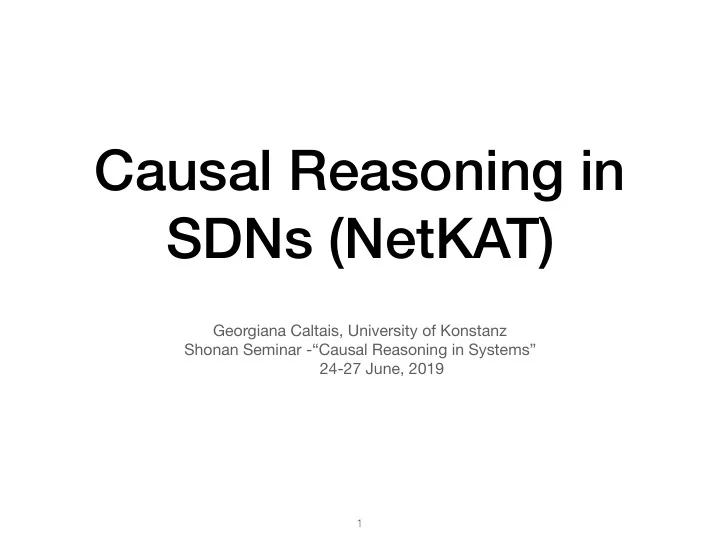

Causal Reasoning in SDNs (NetKAT) Georgiana Caltais, University of Konstanz Shonan Seminar -“Causal Reasoning in Systems” 24-27 June, 2019 � 1
Outline 1. NetKAT - the Language 2. Reasoning & Verification 3. Towards a Framework for Causality Sources: “Programming, Modeling & Reasoning about Networks” (online tutorial by S.Smolka) “NetKAT: Semantic Foundation for Networks” [C.J.Anderson et. al.], POPL’14 “A Fast Complier for NetKAT” [S.Smolka et. al.], ICFP’15 � 2
1. NetKAT - the Language � 3
NetKAT Program - Example � 4
NetKAT Syntax & Semantics
Encoding Switch Forwarding Tables � 6
Encoding Network Topologies (I) � 7
Encoding Network Topologies (II) � 8
Encoding Networks � 9
Encoding Networks � 10
Encoding Networks � 11
Encoding Networks � 12
Encoding Networks � 13
2. Reasoning & Verification � 14
Network Verification • Sound & Complete Axiomatisation [C.J.Anderson et. al.] � 15
Network Verification • Sound & Complete Axiomatisation [C.J.Anderson et. al.] � 16
Network Verification • Sound & Complete Axiomatisation [C.J.Anderson et. al.] � 17
Network Verification • Sound & Complete Axiomatisation [C.J.Anderson et. al.] [[p]] = [[q]] i ff |— p = q • E.g., Reachability: “Does the network forward from ingress (in) to egress (out)”? NO i ff |— in . (switch.topology)* . out = 0 YES i ff |— in . (switch.topology)* . out =/= 0 � 18
Reasoning About Correctness of NetKAT Programs • Programmer 1 has to implement a switch policy s.t.: “H1 can only forward to H2” • Correctness: • H1 can forward to H2 (H1 —>> H2) • H1 cannot forward to H3 or H4 (H1 -/->> H3,4) � 19
Reasoning About Correctness of NetKAT Programs H1 —>> H2 H1 -/->> H3,4 “H1 can only forward to H2” Proven correct based on the axioms! • Policy p1 : (pt = 1 . pt <— 5) + (pt = 6 . pt <— 2) H1 can forward to H2 (H1 —>> H2) • |— (pt = 1) . (p1 . t)* . (pt = 2) =/= 0 H1 cannot forward to H3 or H4 (H1 -/->> H3,4) • |— (pt = 1) . (p1 . t)* . (pt = 3 + pt = 4) = 0 � 20
Reasoning About Correctness of NetKAT Programs • Programmer 2 has to implement a switch policy s.t.: “H3 can only forward to H4” • Correctness: … shown in a similar fashion… • H3 can forward to H4 (H3 —>> H4) • H3 cannot forward to H1 or H2 (H3 -/->> H1,2) � 21
Reasoning About Correctness of NetKAT Programs • Programmer 1: “H1 can only forward to H2” / switch policy p1 • Programmer 2: “H3 can only forward to H4” / switch policy p2 • Assume Programmer 3 implements p as the union of the two correct policies p1 and p2 p = p1 + p2 • Network becomes (p . t)* = ((p1 + p2) . t)* • Does H1 -/->> H3,4 still hold? � 22
Reasoning About Correctness of NetKAT Programs H1 -/->> H3,4 holds i ff |— pt = 1 . ((p1 + p2) . t)* . (pt = 3 + pt = 4) = 0 i ff (acc. to NetKAT axioms) What is the cause? |— pt = 1 . pt <— 4 + P = 0 � 23
3. Towards a Framework for Causality � 24
What Is the Cause? - Obvious Challenges - H1 -/->> H3,4 holds i ff |— pt = 1 . ((p1 + p2) . t)* . (pt = 3 + pt = 4) = 0 i ff (acc. to NetKAT axioms) |— pt = 1 . pt <— 4 + P = 0 provides too contains * little information � 25
What Is the Cause? - Obvious Challenges - H1 -/->> H3,4 holds i ff |— pt = 1 . ((p1 + p2) . t)* . (pt = 3 + pt = 4) = 0 i ff (acc. to NetKAT axioms) |— pt = 1 . pt <— 4 + P = 0 provides too “Star Elimination” little information in [C.J.Anderson et. al] assumption: no dup, no sw <— uses all axioms to build the Normal Form of P , NF (P) |— P ~ NF(P) … provides too little information as well… � 26
What Is the Cause? - Possible Solution - |— pt = 1 . ((p1 + p2) . t)* . (pt = 3 + pt = 4) = 0 i ff (… axioms) |— pt = 1 . pt <— 1 . pt <— 5 . pt <— 6 . pt <— 4 + P sf = 0 Inhibit some of the axioms, e.g.: “Approximate” * f <— n . f <— n’ = f <— n’ [PA-MOD-MOD] (p.t)* = (1 + p.t)^n for some n… and remove *-unfolding axioms � 27
* “Approximation” � 28
Some Terminology… � 29
� 30
Questions? • Current & Future Work: • Trace back the cause into the original code • How does the counterfactual look like? • Handling other interesting network properties • E.g., waypointing… • Responsibility, blame � 31
Recommend
More recommend